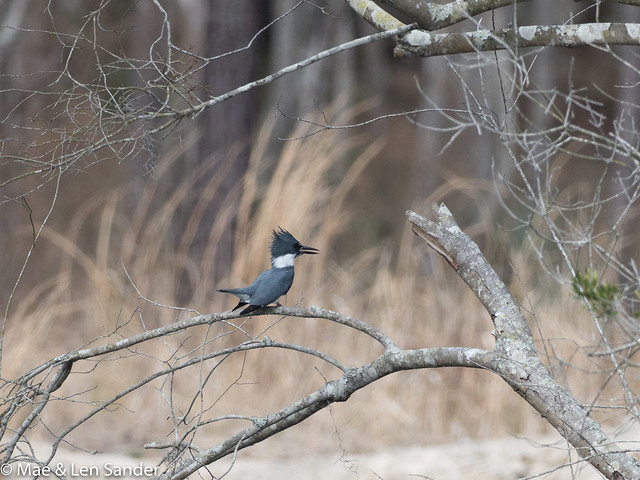Each winter during seven full days of calm
Halcyone broods on her floating nest—
her nest that sails upon a halcyon sea:
the passage of the deep is free from storms,
throughout those seven full days; and Aeolus
restraining harmful winds, within their cave,
for his descendants' sake gives halcyon seas.
-- Ovid. Metamorphoses. Brookes More. Boston. Cornhill Publishing Co. 1922.
Internet source: Perseus Digigal Library.
-- Kingfisher, Tom Yawkey Wildlife Center, S.C.
Of the approximately 110 species of kingfisher found worldwide on every continent except Antarctica, we have seen and photographed three of them on our various birding trips. Most recently, we saw this bird on our trip to South Carolina.
Kingfishers are beautiful birds, often brightly colored or vividly marked. They generally perch briefly on tree branches or utility wires near water where they wait to swoop down and catch fish. There's always something exciting about catching sight of one of these swiftly moving birds in a salt marsh, beside a river, or near a pond.

-- Amazon Kingfisher, Summit Pond, Gamboa, Panama
The ancient Greeks believed that the kingfisher nested during mid-winter, and that the gods provided special calm days, named halcyon days after the Greek name of this bird. In reality, kingfishers lay eggs in holes not nests, but maybe the ancient Greeks didn't know this. Whenever I see the bird, I think of this lovely ancient name for calm seas or just for happy days with beautiful weather. The ancient Greek sailors attributed such luck to the kingfisher: I can see how they loved the bird.

-- Ringed Kingfisher, Maranon River, Peru
Ovid and other classical poets relate the myth of Alcyone (the Greek name for the kingfisher) and her husband Ceyx. Through arrogance, they angered Zeus and Hera, who first punished them with death, and then relented and turned them into birds that nested in winter during a period of calm ordered by Zeus and carried out by her father, Aeolus, ruler of the winds. Myth collector Robert Graves identified several versions of the story, including various stories of her parentage. He identified Alcyone to be a manifestation of a moon goddess from earlier myths.
 |
| Belted Kingfisher from Audubon's Birds of America (1827-1838). |
For more information: https://en.wikipedia.org/wiki/Alcyone_and_Ceyx
Original photos and blog post copyright © 2020 mae sander for maefood dot blog spot dot com.
If you see this at another location on the web, it's been pirated.


I love Kingfishers! I have a river close to my house, about 5 minutes away and there's a couple of kingfishers that live there and they take it in turns diving into the river to catch their food! I wish we could see more in natural habitats :)
ReplyDeleteMakeupMuddle.com
Cute faces!!! (Do birds have faces? Yes, huh!)
ReplyDeleteHelo,
ReplyDeleteI enjoyed this post and the information on the Kingfishers. I did not know how many Kingfishers there were in the world. They are cool birds, I love seeing them. Great photos. Thank you for linking up your post. Enjoy your day, wishing you a happy new week !
What a wonderful post, Mae. I had no idea of all the history. And beautiful birds, these are. Halcyon days -- isn't that the most wonderful phrase? I love it.
ReplyDeleteSuch beautiful birds. Their ability to swallow astoundingly large fish for their size is impressive as well.
ReplyDeleteI did not know that kookaburras were from the same family. My grandfather used to entice them into their garden in Australia. Your photo of the kingfisher nearly in flight is amazing :)
ReplyDeleteOh, what a beauty is that bird! He looks like a very ... just like Calvin, up to something, yet you have to love him! ;-)
ReplyDeleteAnd a sibling of the "lachender Hans", as we call kookaburras over here.
Upps, he got me twice!!!
ReplyDeleteThese are such beautiful birds, so photogenic. We have bright blue kingfishers and they always make you stop and take notice when they are around. Our kookaburras too are so sweet and trusting, they swoop into the pond to cool off only 6 feet away from you. Your pictures and story are very refreshing thank you Mae. P.S. I will enjoy hearing your thoughts on the Russian cookbook.
ReplyDelete